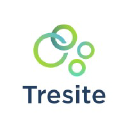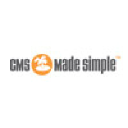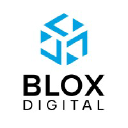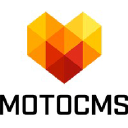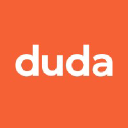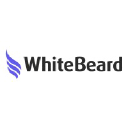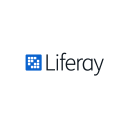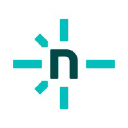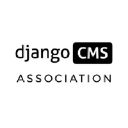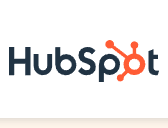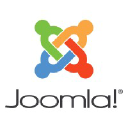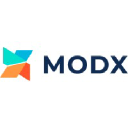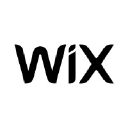
Magnolia CMS
Magnolia CMS
Magnolia is a content management system (CMS) that enables businesses to create digital experiences across websites, mobile, and other channels. It is designed to be user-friendly, flexible, and scalable.
Key Features
- Headless CMS: Magnolia offers a headless CMS architecture, allowing content to be delivered to any channel or device via APIs.
- Visual Page Editor: The visual page editor enables users to create and edit pages without requiring technical skills.
- Personalization: Magnolia provides personalization capabilities to deliver targeted content based on user behavior and preferences.
- Multi-Site Management: The CMS supports managing multiple websites and brands from a single instance.
- Workflow and Collaboration: Magnolia includes workflow features for content review, approval, and collaboration among team members.
- Security: The platform offers robust security features, including role-based access control and SSL encryption.
- Integration: Magnolia integrates with various systems, such as CRM, ERP, and marketing automation tools.
Use Cases
Magnolia CMS is suitable for various industries and use cases, including:
- Enterprise websites
- E-commerce platforms
- Digital experience platforms (DXP)
- Intranets and extranets
- Mobile apps
Deployment Options
Magnolia offers flexible deployment options to fit different business needs:
| Option | Description |
|---|---|
| On-Premises | Deploy Magnolia on your own servers for full control and customization. |
| Cloud | Host Magnolia on a cloud platform like Amazon Web Services (AWS) or Microsoft Azure for scalability and reduced maintenance. |
| Magnolia NOW | A fully-managed cloud offering that provides a hassle-free way to use Magnolia CMS. |
Pricing
Magnolia offers various pricing plans to cater to different business needs. The pricing details are not publicly available on the website, and interested users are encouraged to contact Magnolia for a personalized quote.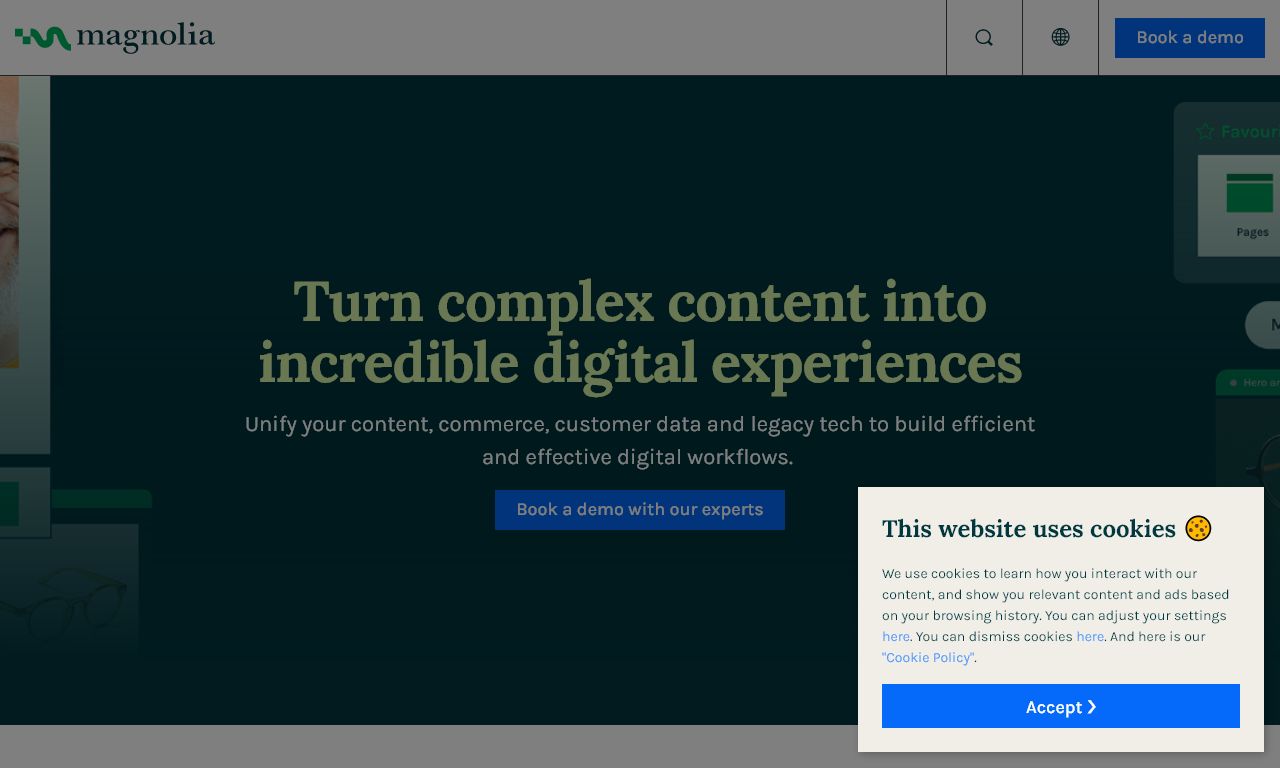
Magnolia CMS
Magnolia CMS is a powerful enterprise-level content management system that offers flexibility and scalability for businesses of all sizes. This review will explore the key features and capabilities of Magnolia CMS, providing insights into its strengths and potential areas for improvement.
1. Overview and purpose of the CMS
Magnolia CMS is an open-source, Java-based content management system designed for enterprise-level websites and digital experiences.
It offers a headless architecture that allows for content delivery across multiple channels and devices.
Magnolia CMS is particularly well-suited for large organizations with complex content management needs and those requiring high levels of customization and integration.
2. User interface and ease of use
Magnolia CMS features a modern, intuitive interface that prioritizes user experience and ease of use.
The drag-and-drop functionality allows for simple content placement and arrangement within pages.
The system utilizes a tree-like structure for content organization, which may require some adjustment for users accustomed to other CMS layouts.
3. Content creation and editing tools
Magnolia offers a rich text editor with standard formatting options and the ability to embed media.
The platform supports in-context editing, allowing users to make changes directly on the live page view.
Content authors can leverage reusable components to maintain consistency across the site and streamline the creation process.
4. Asset management capabilities
The CMS includes a robust Digital Asset Management (DAM) system for organizing and storing various media types.
Users can easily tag, categorize, and search for assets within the system.
Magnolia supports image editing features such as cropping and resizing directly within the platform.
5. Customization and extensibility options
Magnolia CMS is highly customizable and offers extensive options for developers to extend its functionality.
The platform supports the creation of custom modules and templates to meet specific business requirements.
With its API-first approach, Magnolia can be easily integrated with other systems and services.
6. SEO features and optimization tools
Magnolia provides built-in SEO tools to help optimize content for search engines.
Users can easily manage meta titles, descriptions, and URLs for each page.
The CMS generates XML sitemaps automatically and supports the implementation of structured data.
7. Security measures and user management
Magnolia CMS offers robust security features, including role-based access control and SSL support.
The platform provides advanced user management capabilities, allowing administrators to define granular permissions.
Regular security updates are released to address potential vulnerabilities and ensure system integrity.
8. Performance and scalability
Magnolia is designed to handle high-traffic websites and can be scaled horizontally to meet increased demand.
The CMS supports caching mechanisms to improve page load times and overall performance.
According to Magnolia, their CMS can handle up to 100 million page views per month on a single server setup.
9. Integration with third-party tools and services
Magnolia offers a wide range of pre-built connectors for popular third-party services and tools.
The platform's open architecture allows for easy integration with external systems through APIs.
Notable integrations include Salesforce, SAP Commerce Cloud, and various marketing automation tools.
10. Pricing and support options
Magnolia CMS offers both open-source and enterprise editions with varying pricing structures.
The enterprise edition includes professional support, training, and additional features not available in the open-source version.
Pricing for the enterprise edition is based on factors such as the number of authors, environments, and specific requirements.
11. Mobile responsiveness and multi-device support
Magnolia CMS offers responsive design capabilities out of the box, ensuring content displays correctly across various devices and screen sizes.
The platform supports mobile preview functionality, allowing content creators to see how their pages will appear on different devices.
Magnolia's app-based architecture enables the creation of custom mobile apps that can seamlessly integrate with the CMS.
12. Multilingual capabilities and localization features
Magnolia provides robust multilingual support, allowing content to be managed in multiple languages within a single instance.
The CMS offers language fallback options to ensure content availability even when translations are incomplete.
Content authors can easily compare and synchronize different language versions of a page.
13. Workflow management and collaboration tools
Magnolia includes customizable workflow capabilities to streamline content creation and approval processes.
The platform supports task assignment and notifications to facilitate collaboration among team members.
Users can leverage comments and annotations to provide feedback directly within the content editing interface.
14. Version control and content revision history
Magnolia CMS maintains a comprehensive version history for all content changes, allowing users to revert to previous versions if needed.
The system supports content staging, enabling authors to work on draft versions without affecting the live site.
Administrators can easily compare different versions of content and track changes over time.
15. Analytics and reporting functionalities
Magnolia offers built-in analytics tools to track content performance and user engagement.
The CMS can integrate with popular third-party analytics platforms like Google Analytics for more in-depth reporting.
Users can create custom dashboards to visualize key metrics and track content effectiveness.
16. E-commerce capabilities
While Magnolia CMS is not primarily an e-commerce platform, it offers robust integration options with leading e-commerce solutions.
The CMS can be seamlessly integrated with platforms like SAP Commerce Cloud and Shopify to create powerful online stores.
Magnolia's headless architecture allows for flexible e-commerce implementations across multiple channels and touchpoints.
17. Compliance with accessibility standards
Magnolia CMS supports the creation of accessible content that complies with WCAG 2.1 guidelines.
The platform offers built-in accessibility checks to help content authors identify and resolve potential issues.
Magnolia's component-based approach allows developers to create reusable, accessible components for consistent implementation across the site.
18. Documentation and learning resources
Magnolia provides extensive documentation covering all aspects of the CMS, from basic usage to advanced development topics.
The company offers online training courses and certifications for developers and content authors.
Users can access a variety of tutorials, webinars, and case studies to enhance their understanding of the platform.
19. Community support and ecosystem
Magnolia has a growing community of developers and users who contribute to the platform's ecosystem.
The Magnolia Forum serves as a hub for knowledge sharing and problem-solving among community members.
The company hosts regular events and conferences to foster community engagement and showcase new developments.
20. Migration tools and processes from other platforms
Magnolia offers migration tools and services to facilitate the transition from other CMS platforms.
The company provides detailed migration guides and best practices for moving content and assets to Magnolia CMS.
Professional migration services are available for complex projects or large-scale migrations.
Conclusion
Magnolia CMS stands out as a powerful and flexible content management solution for enterprises seeking a scalable and customizable platform.
With its robust features, headless architecture, and strong focus on user experience, Magnolia is well-positioned to meet the diverse needs of modern digital experiences.
While it may require a steeper learning curve compared to some simpler CMS options, the platform's extensive capabilities and integration possibilities make it a solid choice for organizations with complex content management requirements.
Website:

